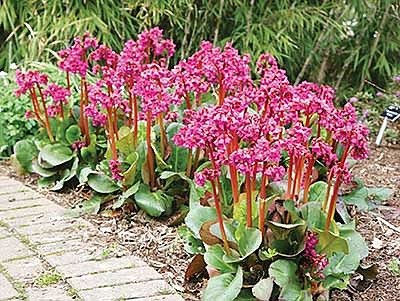
Gardening Journal: Plant of The Month – Bergenia
March brings life back into the garden after the dormancy of the winter. Trees and shrubs start to wake up from their winter hibernation, with the bulbs sending out carpets of colour under the canopy of the mature trees and shrubs. It’s a great time of year for the gardener, as the weather warms up and time spent in the garden can be a little less taxing, with the thought of what’s to come in the following growing seasons, spurring you on to get those last few jobs on the list done.Elephant’s ears are a common sight in many gardens but are often overlooked as being untidy, boring groundcover plants that are used in those tough places where nothing else will grow – a sort of afterthought which are hidden rather than admired. The creeping rhizomes of Bergenia x schmidtii, which is often the variety seen in many gardens, doesn’t do the genus any favour. It has no colour in its winter foliage and flowers so early in the year that it is can easily be damaged by frosts.
Bergenia will grow in those dark shady areas of the garden where nothing else will, however they really do need the opposite, maximum light and exposure in order to get good foliage colour. They grow best in open areas on poorer, drier soils, providing large bold leaf contrasting with ornamental grasses or other thinly textured plants. Most Bergenia’s are evergreen perennials with leathery rounded leaves up to 30cm (12in) across that rise from a stout, iris-like rootstock. Some make tight clumps while others develop a more open habit. Then, as cooler weather sets in, the leaves may develop rich winter colouring - maroon, crimson, bronze and even beetroot red.
If you are wanting the coloured foliage in winter then its best to choose the right variety, Bergenia coridfolia purpurea, Eroica and Overture are all great examples, along with Bergenia 'Abendglocken', B. 'Admiral', B. 'Eric Smith' and B. 'Bressingham Ruby' too. However, the flowers can also be impressive, with cultivars emerging with a greener hue during spring. If planted on an open sunny site, you will be rewarded with a profusion of showy clusters of bell-like flowers during March/April. All shades of white and pink are catered for. However, my favourite would be Bressingham White – the dazzling white flowers really lighting up the spring garden. Early bulbs are ideal partners. Set around clump-forming Bergenias and slip among the roots of those with a more open habit. 'Atkinsii' snowdrops are ideal or try ice-blue Scilla mischtschenkoana, dainty Crocus tommasinianus and wood anemones. I also use them as great edging plants on corners, they provide great structure for the winter garden and a great backdrop for later flowering perennials too.
Although slugs and snails certainly can be an issue, regular tiding up of old decaying leaves will help prevent this. Don’t let this put you off overall, they are an invaluable genus and its about time more people realised the potential these fantastic little plants have.
Jobs to be done in March:
Ornamental Garden:
• A general fertiliser could be applied over borders if felt necessary. If leaves look yellow on shrubs then give them a folate feed (liquid feed via watering can).
• Aerate lawn with a wire rake if mild and not waterlogged.
• Remove any dead, diseased or damaged growth from trees and shrubs.
• Finish mulching if not done in Autumn.
• Put manure/rose feed around all roses and check for dead, diseased or dying shoots.
• Deadhead bulbs regularly.
• Now is a good time to plant new Perennials and summer-flowering bulbs. Re-pot or top-dress all containers.
• Weed regularly.
• Edge/define all borders if not done already.
• Plant Roses.
• Sow hardy annuals for summer colour.
• Repair damage to lawns if necessary.
• Harden off hardy annuals sown under glass.
• Cut back any remaining growth from herbaceous/grasses left over from the winter.
• Divide summer flowering perennials like astrantia, hemorocallis, hosta etc.
• Coppice dogwoods/willows etc if not done earlier.
Vegetable Garden:
• Prune Gooseberries and red and white currants. Remove deadwood and then spur prune all sideshoots back to 2 – 3 buds from the base.Shorten branch tips by one quarter.
• Direct sow shallots and onion setts.
• Harvest the last of the winter crops and compost any un-diseased debris.
• Sow aubergines, cucumbers, tomatoes and chillies in an indoor heated propagator.

